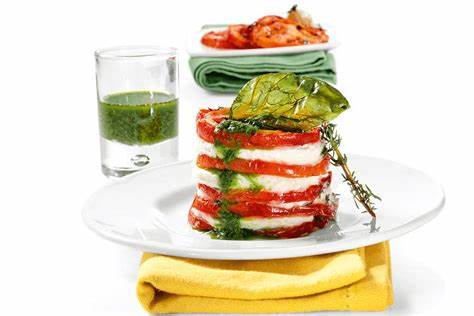|
1. Golden ratio of gelatineThis can be a tricky balance to strike – too little gelatine and it won’t set, too much and the dessert will be rubbery. A ratio of 3½ sheets to 700ml of liquid ensures that the panna cottas set fully but still wobble and melt in the mouth. 2. Keep the gelatine coolPutting the gelatine into ice-cold water ensures it’s very soft but will not dissolve into the soaking water. The cold water hydrates the gelatine’s protein network so it dissolves quickly and evenly. If you were to put a gelatine sheet straight into the hot liquid, it would lump together. Squeeze out as much water as possible from the gelatine when draining it – any excess water will affect the gelatine to liquid ratio. Using leaf gelatine, as opposed to powdered, gives a clearer-looking panna cotta. 3. How to dissolve the gelatineAdding the softened gelatine to the hot cream ensures it dissolves evenly and reaches its full setting capability – make sure not to boil the cream because if the gelatine gets too hot this can stop it from working as well. Pouring the mixture through a fine sieve means you can check if the gelatine has fully dissolved – if there are any small lumps, tip these back into the pan with the cream and heat very gently to dissolve. 4. How to set the panna cottaTo ensure you have vanilla seeds all the way through the panna cottas, leave the mixture in the jug for 5-10 minutes – as it cools it will thicken slightly, meaning the seeds will be suspended throughout once poured into the moulds. 5. Create different flavoursVanilla is just one flavour to try – as long as the cream, milk, sugar and gelatine ratios remain the same, feel free to infuse the cream with ginger, star anise or bay leaves. 6. Which moulds to useThe size and shape of dariole pudding basins are perfect for panna cottas because they taper at the top, meaning once turned out they will have a broad base to hold themselves up. You can use ramekins but, as they’re straight sided, they may sag slightly. 7. How to cleanly remove from the mouldDipping the mould briefly in hot water is the easiest way to cleanly remove the panna cottas. The hot water will melt the gelatine in a very fine layer all the way around the mould, allowing it to slide out freely. Sometimes they stick because of suction – if so, don’t be tempted to cut around the edge with a small knife or you’ll ruin that beautiful, clean finish. Just use a finger to gently pull the panna the side of the mould and the pudding should free itself. Ingredients
0 Comments
For 4 person 4 large pasteurized egg yolks 2 large pasteurized egg whites 10 tbsp. (125 g) sugar 1 cup (250 g) mascarpone 5 tsp. (25 ml) brandy (optional) 1 cup (200 ml) sweetened coffee 8 savoiardi (lady fingers) unsweetened cocoa powder, as needed
In a bowl, beat the eggs yolks with most of the sugar, heating the mixture slightly in a heatproof bowl that fits snugly over a pot of barely simmering water. In another bowl, whisk the egg whites with the remaining sugar. Stir the mascarpone into the egg yolks, then add the stiff egg whites and carefully fold so the mixture remains light and frothy. Dip the lady fingers in the sweetened coffee (if you wish you can add a little brandy) and place them in the bottom of a dish (or in four small dishes or glasses). Then pour in a layer of the cream mixture and continue alternating layers of biscuits and cream. Refrigerate the tiramisù for about two hours. Garnish with a generous sprinkling of cocoa. FOR THE DOUGH 3/4 cup plus 1 tbsp. (100 g) pastry flour 2 tbsp. (10 g) unsweetened cocoa 3 1/2 tsp. (15 g) sugar 1 large egg 1 tbsp. marsala wine or rum 1 tbsp. (10 g) unsalted butter 1 pinch salt FOR THE FILLING 9 oz. (250 g) fresh ricotta (preferably made from sheep’s milk) 1/2 cup (100 g) sugar 1 oz. (25 g) candied fruit, roughly chopped 1 oz. (25 g) dark chocolate, roughly chopped 1 oz. (25 g) pistachio nuts, roughly chopped olive oil for frying, as needed confectioners’ sugar, for decorating
Combine the flour, cocoa, butter, egg, sugar, and a pinch of salt on a work surface; then add the marsala and continue to knead. When the dough is homogeneous, let it rest for about 30 minutes. Meanwhile, prepare the filling: Pass the ricotta through a sieve into a bowl, stir in the other filling ingredients, and refrigerate. Roll out the dough and cut it into 4-inch (10 cm) squares. Wrap the squares diagonally around metal cannoli tubes. Pour enough oil into a Dutch oven or other heavy pot so that it will be deep enough to submerge the cannoli. Heat the oil, and when hot, fry the cannoli for 1-2 minutes. As soon as the dough becomes golden, remove from the oil, drain on paper towels, and let cool. Then remove them from the metal tubes. Spoon the cannoli filling into a pastry bag and fill the cannoli. Dust with confectioners’ sugar and serve immediately. (After some time, the humidity of the filling will make the dough lose its crispness.)  Heat the oven to 200°F (100°C). Slice the tomatoes, and arrange them on a baking sheet. Sprinkle with salt, a little sugar, the garlic, and thyme. Drizzle with olive oil and bake for about an hour. Meanwhile, bring a medium pot of water to a boil. Dip the basil in the water and then plunge into ice water. Puree the basil leaves in a blender with the 3 1/2 tbsp. (50 ml) olive oil. Slice the mozzarella and season lightly with salt and pepper. Make the stacks by layering the mozzarella and semi-candied tomato slices. Drizzle with olive oil and garnish with the basil sauce. 9 oz. (250 g) buffalo mozzarella 3 1/2 tbsp. (52 ml) extravirgin olive oil; more for drizzling 4 ripe tomatoes 1/2 oz. (15 g) fresh basil, or about 30 leaves sugar garlic, finely sliced fresh thyme salt and pepper 4 Servings Heat the oven to 300°F (150°C). Boil a medium pot of salted water. Add the broccoli and cook until the stems are tender when pierced with a fork. Plunge in ice water, then drain. Put the broccoli in a blender. Add the cream, Parmigiano-Reggiano cheese, and eggs. Blend until smooth. Season with salt and pepper. Butter individual ramekins or timbale molds and fill with the broccoli mixture. Put the ramekins in a hot water bath (a bain-marie or a roasting pan filled with hot water halfway up the sides of the ramekins) and bake for about 40 minutes. Meanwhile, prepare the anchovy sauce. Rinse the anchovies, fillet them if necessary, put them in the blender with the oil and blend until smooth. When the flans are cooked, remove them from the water bath and let them cool slightly. Invert the flans onto individual serving plates and garnish with the anchovy sauce. 9 oz. (250 g) broccoli, or about 1 1/2 cups florets 2/3 cup (150 ml) cream 1 oz. (25 g) grated Parmigiano-Reggiano cheese, or about 1/4 cup 3 large eggs 2 tsp. (10 g) unsalted butter salt and pepper For the sauce 2 salted anchovies 2 tbsp. (30 ml) extra-virgin olive oil
|
AuthorVinci Coppolas Archives
April 2024
Categories
All
|
© 2015 - 2022 Vincicoppolas Pizzas - London UK
Vincicoppolas Catering Vincicoppolas Pizzas original Italian pizza catering service Essex [email protected]
Vincicoppolas Pizzas Ltd, a limited company registered in England and Wales under company number 13403248 Our registered office is:
86-90 Paul Street, London, England, United Kingdom, EC2A 4NE
86-90 Paul Street, London, England, United Kingdom, EC2A 4NE






 RSS Feed
RSS Feed
